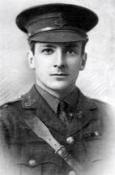
War Memorial
| Captain Edward Wilberforce LEATHER | |
|
2nd Battalion Yorkshire Regiment attached to the 2nd Battalion King’s Own Yorkshire Light Infantry Date of birth: 23rd November 1879 Date of death: 18th April 1915 Killed in action aged 35 Commemorated on the Menin Gate Addenda Panel 57 |

|
| Edward Wilberforce Leather was born at The Friary, Tickhill on the 23rd of November 1879 the third son of Frederick John Leather JP of Middleton Hall, Belford, Northumberland and Gertrude Elizabeth Sophia (nee Walters) of “The Friary”, Tickhill in Yorkshire. He was educated at Hazelwood School until April 1893 when he left for Wellington College where he was in Mr. Brougham's House from May 1893 to 1896. He was commissioned as a 2nd Lieutenant in the 3rd Battalion Yorkshire Regiment (5th West Yorkshire Militia) on the 15th of February 1900 and was promoted to Lieutenant on the 13th of December 1900. He served in the South African War from February 1900 to the summer of 1902 and was awarded the Queen’s Medal with two clasps and the King’s Medal with two clasps. While he was in South Africa he was taken ill with yellow fever and jaundice in 1900 but made a full recovery. He resigned his commission in 1904 after which he worked as a motor engineer. Following the outbreak of war, he applied for a commission in the Special Reserve of Officers for his old regiment on the 9th of August 1914 and was granted a commission, with the rank of 2nd Lieutenant, on the 4th of September 1914. He was attached to the 2nd Battalion King’s Own Yorkshire Light Infantry and embarked for France on the 25th of November 1914 with a detachment of 190 men and three other officers as replacements for the battalion. He joined the battalion in the field on the 1st of December while they were in trenches to the east of Wulverghem. He was promoted to Captain on the 1st of February 1915. In April 1915 the British High Command was determined to remove the Germans from the position known as Hill 60, in the Ypres Salient. Although made of the spoil from the construction of a nearby railway cutting, and only fifty feet high, the feature dominated the flat Belgian landscape and enabled the enemy to spot for its artillery to great effect. In order to remove them, six mine shafts were driven under the hill and charged with high explosive. These were to be blown on the 17th of April 1915; this would be immediately followed up by an assault by the British infantry to kill or capture the defenders and occupy the hill. On the morning of the 17th of April the 2nd Battalion King's own Yorkshire Light Infantry left their billets at Reninghelst to move forward to Ypres in preparation for their part in the attack. As they were making way to Ypres the attack began with the exploding of the six mines at ten second intervals which was closely followed by a heavy bombardment of high explosive from the British artillery lasting fifteen minutes. As soon as this finished the men of the Queen's Own (Royal West Kent Regiment)and the King's Own Scottish Borderers poured out of their trenches and, despite fierce resistance and two counterattacks from the defenders, carried the enemy positions. At dawn on the 18th of April 1915 the enemy counterattacked once again, forcing the Scots out of their positions and regaining the summit. At 7am that morning the KOYLI moved forward from Ypres to reserve positions below the hill, where they replaced a battalion of the Duke of Wellington's Regiment who had in turn moved forward to relieve the Borderers. At 12.30pm the battalion moved into a larch wood below the hill where they came under heavy shell fire. Edward Leather was wounded by shrapnel in the face in the early afternoon and by a rifle bullet in the cheek, but refused to leave the field. At 3pm orders came through that the hill must be retaken at all costs and that the Duke of Wellingtons and KOYLI would make the assault. At 5pm the KOYLI moved forward to trenches some 80 yards from the foot of the hill and at 6pm C and B Companies dashed forward from the trenches and began the attack. A Company followed close behind carrying spades and hand grenades and D Company remained in reserve. As soon as the leading companies emerged from their trenches they came under very heavy artillery, rifle and machine gun fire and began taking casualties. Edward Leather was among them. In spite of their casualties the battalion swept up the hill, gathered the Duke of Wellington men whose attack had stalled, and took the hill. The German defenders fled in panic but were impeded by the number of their own dead and wounded choking their communication trenches and most were captured or killed by the Yorkshiremen. With the hill taken A Company quickly built up the rear of the trench in preparation for the inevitable counterattack which duly came. Forty four German gun batteries opened fire on the hill which was followed by determined infantry attacks but the KOYLI held their ground throughout the night. They were relieved at dawn on the morning of the 19th of April having suffered casualties of nine officers killed or died of wounds with six officers wounded and twenty five other ranks killed with one hundred wounded and ten missing. His mother received the following telegram dated the 21st of April 1915: - "Deeply regret to inform you that Captain E.W. Leather Yorkshire Regiment was killed 18 April. Lord Kitchener expresses his sympathy." His brother, Lieutenant Christopher Leather 1st Battalion Northumberland Fusiliers, was killed in action on the 26th of October 1914. He is commemorated on the war memorial at Tickhill, on the memorial at Belford in Yorkshire and on the memorial at Wellington College. |
|
| Went on to Wellington College |
Back